Hiking over the Himalaya Mountains
I hiked over one of the world’s highest mountain passes in a four-week journey, part of a three-month backpacking trip through Nepal and India. This blog describes the hike, some of the people I met and their life in the Himalayas, altitude sickness and helicopter rescues, and methods I used to complete the trek without pain medications; part of my intention of this trip was to stop taking medications for pain because they led to a sluggish mind and unwise decisions.
The Path
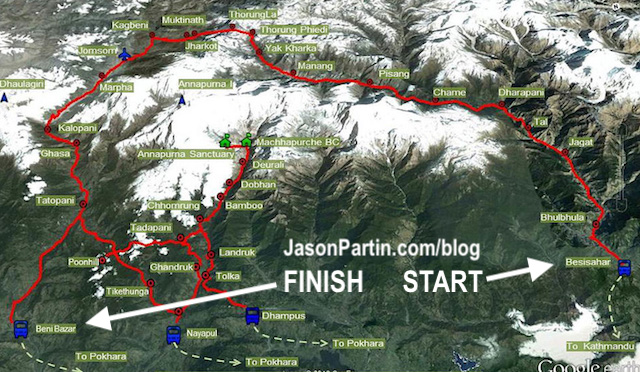
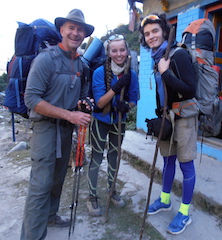
I took a bus from Kathmandu to the village of Besisahar, being dropped where the dirt road ended and a hiking trail began. Most of the trail is known as the Annapurna Circuit, a centuries-old trading route betweenNepal and what was formerly Tibet before the People’s Republic of China assumed ownership in 1950.
The Annapurna trail is still used by locals and adventurous tourists. It cuts into the sides of mountains, crossing rivers with suspension bridges swinging hundreds of feet in the air. Two people could not pass on the narrow bridges, so we’d coordinate who went first. Goats, cows, and buffalo used the bridges; I gave right-of-way to anything with horns, and played with anything that was cute.


I had a backpack with two months worth of clothes, a few day’s worth of food and water, a few books, a camera, and a Frisbee. Other than socks and underwear, my gear and clothes were purchased from thrift stores near my home in San Diego, California, for less than $50 total. I also purchased a lightweight down jacket made from Patagonia, California’s first Benefit-Corporation that combines socially responsibility with being profitable-enough. (I would love #ProfitableEnough to become a common concept)
The Annapurna trail passes through villages, passing people’s front doors. Most families offer simple beds and dinners to travelers. Their ancestors had done the same thing to Tibetan traders for generations.


Most villages don’t have schools. Some do, and nearby villagers walk the trail for hours to reach them. There are not medical services. Poverty is common, and the area was recovering from a recent civil war that killed 19,000 people and displaced 200,000. Foreign aid doesn’t reach them. Despite these challenges, the Himalayan people are kind, industrious, hard-working, and peaceful. Himalayan people say, “what is there to do?” as a way to be present in the moment and only worry about what is within their control.

Part of what’s in everyone’s control is our kindness towards others. Nepali culture encourages compassion, shown by how kids would run into the street to greet me when I approached a village. They’d clasp their hands, bow, and say “Namaste,” the Hindu word for “I see the divine in you.” I’d clasp my hands, bow, and wait to feel the sentiment before returning the word, “Namaste.”
Feeling compassion and speaking truthfully makes everyone happier. Imagine if our culture encouraged pausing to seek compassion for a person before saying, truthfully, “I hope you’re well.”
The poorest backpacker is wealthier than these kids can imagine, and many share treats. A consequence is a that kids start seeing backpackers, most of whom are caucasian (white), as sources of things rather than as people. They don’t say Namaste, they shout, “Money! Chocolate! Sweet!” You can’t see the divine in each other with a hierarchical relationship, so I gave the most valuable thing I have, time.
Many Himalayan families had been in travelers’ photos, but had never used a camera or seen their own picture. I lent my camera to kids, letting them learn by playing with it.

They’d take photos of their parents, show them, and try again with new button combinations. In return, they’d teach me Nepali words for what they saw. This is co-learning, a powerful tool for connecting with students.
Kids took many of these photos, letting us see the world through their eyes.
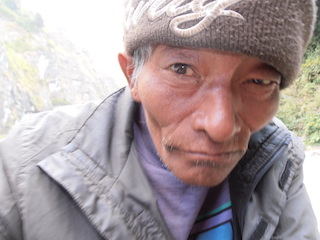
I was hiking uphill each day, gaining 400-500 meters of elevation. Each night got colder; before going to bed, I’d huddle around kitchen fires, learning to cook Himalayan food while talking with families.

Most guest houses were people’s homes, and they juggled family duties while preparing our dinners. One host, Narme Llama, was a third-generation Tibetan with newborn twins. He had a warm smile, had learned four languages, and helped take care of his new daughters while running his business.
I arrived at the end of season without tourists, so a bed was free. A meal cooked over their wood stove was 200 Rupees ($2 U.S.). Ginger tea was 60 Rupees. They saved money to send their older daughter to boarding school in the nearest city, two-days away, for $15/month. They were lucky to save $2 per month, which would have to support them in old age. There were no schools nearby, and all jobs were physical labor that didn’t need an education, but Narme-Llama valued education. He realized their government wouldn’t build roads, schools, or hospitals in rural areas, but was grateful for his family and the values installed by his grandfather that helped make their exile from Tibet and independence in the Himalayas peaceful, despite being viewed as unwelcome refugees. Images of Buddha were on the walls; the Buddha taught how to seek your own happiness, because no one else can do that for you.
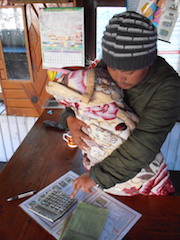
Sometimes a guesthouse would have other backpackers, or travelers with a guide, and we’d share time around a fire learning different perspectives on the world.

Some travelers had smart-phones with translation apps and solar-chargers, allowing us to communicate with almost anyone. Even tiny villages had WiFi; people couldn’t get toilet paper, but could browse the internet. Our world could be moving towards a global democracy, where people solve problems rather than politicians, or we could could be moving towards replacing democracy with “dataism.” (Read “Homo Deus.”) Wherever we’re going, 7.6 billion people using smart-phones will get us there faster.
After a week of hiking the villages became smaller and farther apart. Hiking became more challenging because of the high altitude; everything was over 10,000 feet (3,000+ meters, almost two miles high). I hiked uphill 4 to 8 hours per day, gaining approximately 500 meters before stopping to sleep and acclimate. Trees became rare, and snow-capped mountains became common. Tibetan prayer-flags highlighted mountains I’d eventually cross.

At higher elevations, people from poor castes walk downhill to collect firewood each day, walking back uphill to sell it. Tourists use more firewood than the local ecosystem can resupply; to balance this, the government agency overseeing this area has encouraged gas stoves. The alternative was burning yak-dung, which isn’t as smelly as you’d imagine, but I wouldn’t try it at home.

Mules resupply villages with gas tanks and food that can’t be grown in high elevations. The mules also brought supplies for tourists, like Snickers candy bars that would be sold to hungry hikers by guest-houses.


In the town of Manang we had to wait four days because all guest-houses in the region were full of people from Kathmandu, who had traveled to vote in the national election. In Nepal, people must vote in the town they’re registered, usually where their ancestors were born. This was Nepal’s second election; their democracy was new, and followed a ten-year civil war that had divided the people between the poor and wealthy.
Nepali soldiers patrolled the streets, enforcing a curfew with guns rather than logic. Nepal uses their soldiers as defense, police, and national park protection. Until the civil war, they were the only people with guns, and without checks-and-balances they abuse their power in rural areas. I believe this will change now that Nepal has a democracy; I’ve never had a gun pointed at me in a country with a functional democracy.

The curfew didn’t affect our stay in Manang because there was nothing to do at night, especially when temperatures were below freezing. We’d walk up and down the street then return to our guesthouse to get warm around a yak-dung fire.
The guesthouse where we stayed was decorated for what the owners imagined a typical traveler would enjoy. Their home look like a rustic version of a 1970’s television sitcom; for some reason, they assumed that a typical traveler expected a Tiki bar. We’d sit under the Tiki bar, heating our tea in steel mugs on the yak-dung burning stove.
Frisbees are surprisingly useful for meeting people, and not just when throwing it. One of our group had found a wild herb in the lowland mountains and used my Frisbee to prepare it for sharing with our small group. Use your imagination…

We spoke with local families about the election. Most people didn’t understand the differences between political ideologies, they simply hoped for a better life. The communist party overwhelmingly won elections in rural areas. In cities, the status-quo remained. Their new democracy would share government decisions between parties. Regardless of this year’s outcome, it’s a step towards more people having a voice in their future. They celebrated with parties in the street.

After the elections, I started hiking through remote areas. My head hurt from spinal injuries, my hips hurt from arthritis and inflammation, and the screws in my ankle caused the bones to throb with pain. I walked silently, concentrating on being mindful, something I’ll discuss more soon.
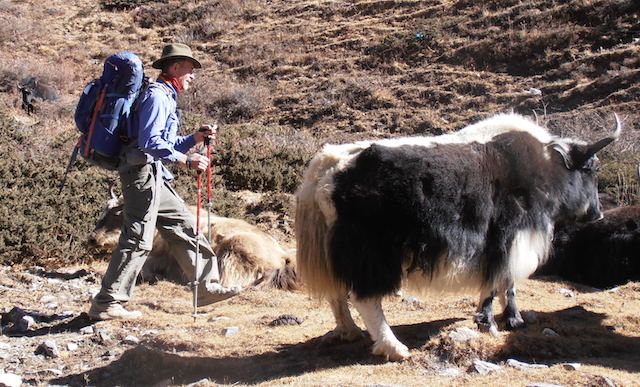
You see more wildlife when walking silently. Some, like this yak, are not subtle. Others are easily missed; there are at least four mountain goats in this photo:

And at least two in this photo:

Many people do not get altitude sickness. I’m not one of them. The photo below was taken from the window of a shelter, where I stayed for three nights to recover from altitude sickness before risking the final day of hiking.

For almost a week, I had been hiking at over 3,400 meters (~11,000 feet), gaining 300-500 meters each day. I had a headache and craved oxygen. My body fought two needs: deep breaths to get oxygen vs. tightening my windpipe to keep out the cold, dry air. I have asthma, and my breath “wheezed” on steep sections of the trail.
When you’re emotionally detached from discomfort, you’re able to differentiate between transient discomfort and symptoms of altitude sickness. At 4,880 metres (16,010 ft, ~ 3 miles) I realized that my headaches and dizziness were signs of trouble, so I descended to a shelter at 4,540 meters.

I stayed in a small room with one window that allowed cold wind into the room. I laid awake for hours, trying to stay warm as ice formed in my water bottle. It was -17 degrees by 2am. My heart was pounding at 124 beats per minute, more than twice my normal resting rate. Every muscle in my body was tense, sending blood to vital organs. I couldn’t descend; in daylight, it was six hours down a narrow and dangerous trail to the next shelter. I concentrated on relaxing until my jaw unclenched, which led to my teeth chattering at 124 beats per minute. I had preferred a clenched jaw.
By sunrise, my pulse was down to 80 beats per minute. I didn’t move that day, and by that evening my pulse was ~ 60 beats per minute, still more than my normal resting rate, but reasonable considering I was 3 miles high.

I acclimated by hiking to higher elevations during the day, descending to sleep at night. On one of these hikes, I found an emergency satellite phone. Three years prior, almost 400 people were trapped at this location by a surprise snowstorm; 42 died, and 175 suffered frostbite. I was not reassured by the satellite phone, which was made from a coffee can and something that looked like the dish-drying rack by my sink at home.
I’ve summitted mountains all over the world, and frequently rock-climb in the Sierra Nevada mountains, where the amount of focus for each motion makes you not notice almost all other thoughts or feelings. This requires concentration; your mind is sluggish from high altitudes, low oxygen, and physical exertion, and it wants to be anywhere other than the present moment. Hiking above 17,000 feet can require 10 to 15 seconds of focus per step, requiring 6-8 hours of unbroken concentration. For me, I also must remain aware of the nature of pain in my body. For example, the metal screws in my ankle can wear into the bone, leading to a risky situation if I can’t walk effectively, and my normal headaches must be continuously evaluated to ensure it’s not progression to severe altitude sickness.
If you think about how difficult it is to concentrate on something unpleasant you have an idea of the real challenge of high-altitude hiking, maintaining concentration on both pleasant and unpleasant feelings 6-8 hours per day for several weeks.
Here’s my metaphor for being mindful while hiking. You’re the pilot of a bus that represents your body and passengers that represent your thoughts. You’re responsible for piloting the bus and being aware of the passengers. The road and other drivers are external situations often out of your control, but you must be aware of them, too. Sometimes your bus isn’t in perfect condition, you may have deflated tires or weak shock absorbers, but you must still pilot it over any road condition. Your passengers are like kids on a bus, sometimes joyful sometimes crying and always there.The passengers constantly tell your about your deflated tires, weak shock absorbers, pain in your ankle, pain in your neck; they warn you to look out for other buses even when the risk is negligible; they worry about where you’re going or question where you’ve been; they ask about work project you need to finish, wonder what other people in your life are doing, and talk about other aspects of your life not relevant to the immediate situation of piloting your bus over a rough road with weak shock absorbers and the potential to get a flat tire. But, some of those voices are telling you when to rest, ensuring your headache is not a symptom of life-threatening altitude sickness, notifying you of potential risks to avoid such as slippery ice or a possible avalanche or another driver on the road out of control, and other things critical to your safety at the moment.
Your challenge is to acknowledge the voices of all passengers while maintaining focus on piloting your bus regardless of its condition. You can simultaneously acknowledge pain, shortness of breath, worry, anxiety, fear, calmness, and joy while concentrating on being in control of your bus while other drivers are on an ever-changing road.
I focused on piloting my bus and eventually reached Thorang-La Pass, 5,416 meters above the see, almost 3.4 miles in the sky.
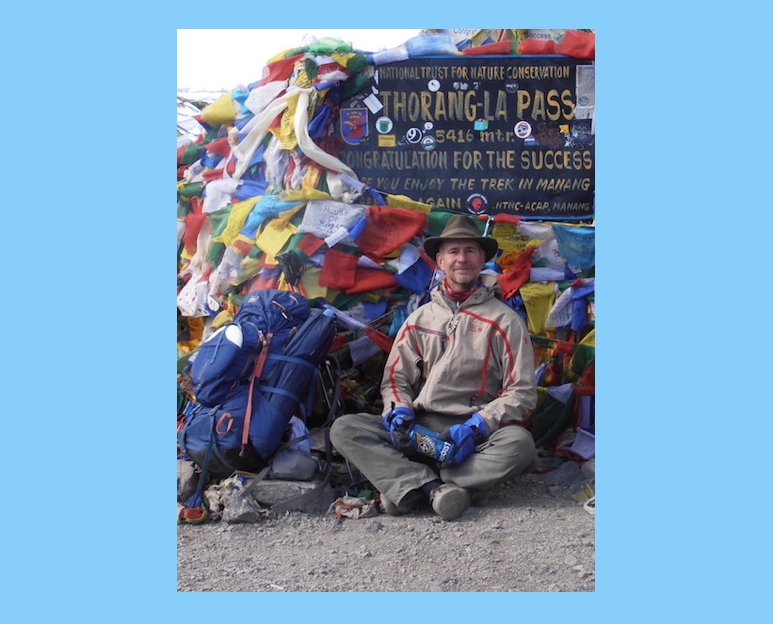
As soon as I sat down to rest I realized that one of the other four people there was suffering severe altitude sickness. Her eyes were rolled back into her head, her breathing was in brief gasps, and her pulse was more than 150 beats per minute. She was in shock, and it was likely that pressure was building insider her brain.
None of us spoke the same language; we carried her into the tea hut while her guide was trying a satellite phone to call help. Over the next few hours, we kept her warm in the tea shop while preparing a helicopter landing zone. We carried her and her bags onto the helicopter, which would prioritize getting her to a lower elevation, and then to a hospital.


Shortly before reaching the summit I had a cup of tea in a coffee shop, of sorts. A cheerful entrepreneur had brought gas stoves and tea to a shelter at 17,900 feet. I paid $1.50 for a cup of hot tea; I would have paid a hundred. We kept the woman warm in her hut; I wonder what she would have paid.

The helicopter cost $10,000. It was a private service, and the patient’s guide received a commission for calling it. The tea shop entrepreneur made $1.50. Three years ago, when the storm trapped 500 people here, local people dug through snow without concern for how they would get paid. There’s no right or wrong, just facts. Mindfulness is being aware of facts, but differing judgement until those facts are necessary to make a decision.
I was alone again when the helicopter left and started walking down the other side of the pass. I had been so focused on the rescue that I hadn’t felt pain or symptoms of altitude sickness. I started to notice the pain again. Descending steep trails is harder on your joints than hiking uphill, and my head and joints screamed with pain. When I had descended enough to reduce the effects of altitude sickness, I stopped to eat a Snickers. It was the first food I could hold down in 24 hours; at that moment was the most delicious thing I had ever eaten. In the time it took for my teeth to break through a peanut, all discomfort faded. I had no thoughts, just awareness. The experience continued for several weeks and to a lesser extent remains a year later.
I’m not exagerating that this hike was a life-altering experience. I have a difficult time describing the feeling it because words don’t exist. I’ve read people who believe it’s a call from God, a spiritual awakening, or simply the by-product of brain neurons rearranging to detach from feelings of suffering and attaching to feelings that are more healthy. Some people simply are that way naturally, always seeming positive without worry or unhealthy focus. It took me almost a year to try describing what happened to me, including what’s continued to work for a year, in another article on mindfulness and meditation.
The short version is I benefited from simultaneously focusing on my pain and altitude sickness with the joy of eating a Snickers while being aware that from that point my journey was all down-hill, both literally and metaphorically.
I walked downhill for a few more hours, found a guest house, and enjoyed the sunset. The sunset was beautiful because of ice crystals forming in the air; the lenticular clouds coming from mountain peaks indicated pressure was building and snow would arrive. Two days later it began snowing on the mountain pass I had just summited, and it was raining in the areas of where I would spend the next two weeks. I started hiking through the rain, going off-the-beaten-path and into the Kingdom of Mustang.

Other blogs share key experiences during this trip through Nepal and India. Too much happened to list every detail, but many come out at appropriate times with friends. Many of my side-stories are interesting in the context of main stories in these blogs. If you and I meet, I hope we spend enough quality time together to share stories.
Continue to:
Or, jump forward two weeks:
